Chevrolet Captiva Owners Manual: Fuses and Circuit Breakers, Engine Compartment Fuse Block
Fuses and Circuit Breakers
The wiring circuits in the vehicle are protected from short circuits by fuses. This greatly reduces the chance of circuit overload and fire caused by electrical problems.
There are two fuse blocks — the engine compartment fuse block, and the instrument panel fuse block.
To identify and check fuses and relays, refer to the Fuse Usage Chart on the inside surface of the fuse panel door or cover.
Engine Compartment Fuse Block
The engine compartment fuse block is on the right side of the engine compartment, near the battery.
Caution
Spilling liquid on any electrical component on the vehicle may damage it. Always keep the covers on any electrical component.
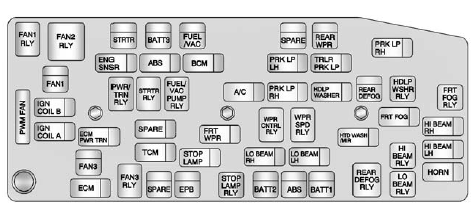
The vehicle may not be equipped with all of the fuses, relays, and features shown.

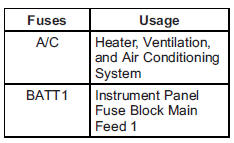
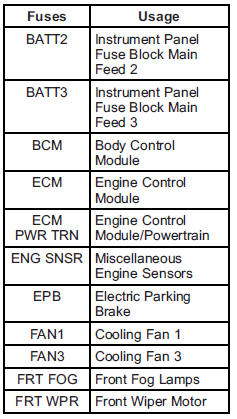
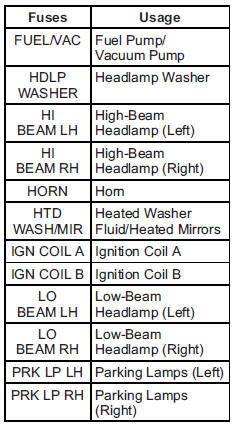
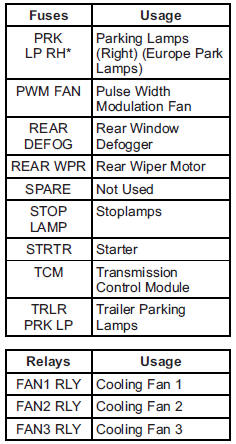
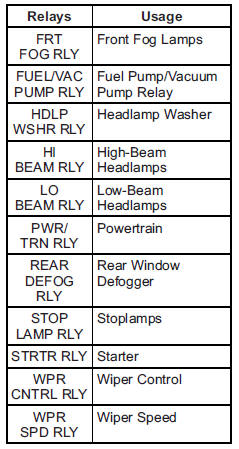
Engine compartment fuse block in 2014 Chevrolet Captiva is a critical component that safeguards various electrical circuits within the vehicle. To access it, locate the fuse block near the battery or firewall in the engine bay. Refer to the owner's manual or the fuse block cover for a detailed diagram illustrating the function and amp rating of each fuse and circuit breaker. This information helps identify the specific electrical components protected by each fuse or breaker.
Regular inspection of the fuses and circuit breakers is essential for maintaining the electrical systems' functionality. Visually inspect each fuse and circuit breaker for any signs of damage, such as a blown fuse with a visible break in the metal strip or a tripped circuit breaker with the reset button popped out. Use a multimeter set to continuity mode to test for continuity across the fuse or breaker, ensuring they are working correctly.
When replacing fuses or resetting circuit breakers, always use replacements with the same amp rating to avoid damaging electrical components or causing electrical malfunctions. The fuse puller tool located in the fuse block or a pair of needle-nose pliers can safely remove and replace fuses. After replacement or resetting, test the associated electrical component to confirm proper functionality. If issues persist or if multiple fuses continue to blow, seek professional diagnosis and repair to address any underlying electrical problems in Chevrolet Captiva 1-st generation.
 Electrical System Overload
Electrical System Overload
The vehicle has fuses and circuit
breakers to protect against an
electrical system overload.
When the current electrical load is
too heavy, the circuit breaker opens
and closes, protecting the ...
 Instrument Panel Fuse Block
Instrument Panel Fuse Block
The instrument panel fuse block is
on the passenger side of the lower
console.
Pull the latch of the fuse box cover
straight back to access the fuses.
The vehicle may not have all of the
...
More about:
Chevrolet Captiva Owners Manual > Vehicle Checks: Ignition Transmission Lock Check, Park Brake and P (Park) Mechanism Check
Ignition Transmission Lock Check
If equipped with a key type ignition,
while parked and with the parking
brake set, try to turn the ignition to
LOCK/OFF in each shift lever
position.
The ignition should turn to
LOCK/OFF only when the shift
lever is in P (Park).
The ignition key should ...
Chevrolet Captiva Owners Manual
- Introduction
- In Brief
- Keys, Doors, and Windows
- Seats and Restraints
- Storage
- Instruments and Controls
- Lighting
- Infotainment System
- Climate Controls
- Driving and Operating
- Vehicle Care
- Service and Maintenance
- Technical Data
- OnStar
